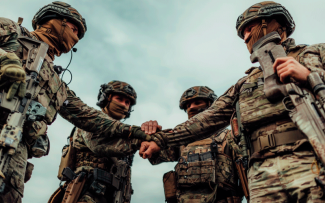Ukraine halts formation of new brigades. Day 1077 of the war


Fighting continues for control of the communication routes on Pokrovsk’s flanks. Russia has increased its holdings, but has failed to advance deep into the defenders’ grouping. Ukrainian troops are gradually withdrawing from the salient west of Kurakhove, trying to prevent the only evacuation route to the west from being cut off. The Andriivka-Kostiantinopil road junction, which makes it possible, is being attacked by the Russians from the north-east and from the south. The remnants of Ukrainian forces in the Velyka Novosilka area have retreated behind the Mokri Yaly River.
The Russians have expanded the controlled area on the outskirts of Toretsk. However, part of the mines in the north of this town and the bordering village of Krymske remain under the control of the defenders. The flanking of Ukrainian forces in Chasiv Yar has deepened, and fighting for control of the centre continues. Russian forces are developing bridgeheads on the right bank of the Oskil River north of Kupiansk and on the right bank of the Zherebets River north-east of Lyman.
According to Ukrainian sources, in order to improve logistics, the Russians have started repairing roads in the occupied territories. It remains an open question whether this is only to help operations on their current scale or whether they are preparing to intensify them.

On 1 February, the Russians launched another massive strike against Ukraine using missiles and drones. Its target – unlike previous ones – was the direct rear of the defenders. Damage to the energy infrastructure in Zaporizhzhia and Myrhorod was confirmed, while similar impacts were also reported from Kharkiv, Pavlohrad and Poltava (14 people were killed, 20 injured), as well as the Kyiv and Odesa oblasts. As a result of the attack, emergency power cuts were imposed in seven regions. For the first time since the start of full-scale aggression, the Ukrainian side did not declare the number of missiles shot down. According to the Air Force Command, Russia used a total of 46 of them, and “some of the cruise missiles” were downed (the Russians are thought to have used 27 of them). In its daily summary, the Ukrainian General Staff reported 40 missiles used by the enemy, but gave no information on shoot-downs. Of the 123 drones used by the Russians, 56 were to be downed and 61 location lost.
Repeated drone and single missile attacks by Russia have exacerbated power supply problems in Ukraine’s southern and eastern regions. On 3 February, they caused emergency disconnections in nine oblasts and on the following day in eight oblasts, while as recently as the end of January, this procedure was still being applied to single oblasts. Particularly noteworthy were the drone attacks on Izmail’s port infrastructure (29 and 30 January) and the three missile strikes on Odesa in quick succession (night of 31 January – 1 February), which resulted, among other things, in damage to the city’s historic centre. From the evening of 28 January until the morning of 4 February, Russia is thought to have used a total of 554 drones and 57 rockets. Ukraine declared 296 drones and at least one missile shot down, while 217 drones were described as location lost.
On the evening of 1 February, a former boarding school building in Sudzha, Kursk Oblast, which had been turned into a temporary residence for civilians by the occupying Ukrainian forces in the city, was damaged, most likely by a Russian guided aerial bomb explosion. Of the 90 people present in the building, four were killed and another four injured. Kyiv publicised the incident, indicating that the Russians were attacking their own citizens. In turn, the Russian broadcast considered it to be a Ukrainian false flag allegedly carried out with a missile from a HIMARS launcher.

As a result of Ukrainian drone strikes, the SIBUR-Kstovo refinery in the Nizhny Novgorod Oblasts topped work on 29 January, as did a gas processing plant near Astrakhan on 3 February. Kyiv also reported damage to the Druzhba oil pipeline pumping station in Bryansk Oblast (30 January) and the Lukoil refinery in Volgograd (31 January and again on 3 February). According to some sources, an oil pumping station and an ammunition arsenal in Tver Oblast were also attacked on 29 January (a military unit’s buildings are thought to have been damaged there), and a thermal power station and a fuel base in Volgograd two days later.

Ukrainian services have noted a high level of activity by individuals cothe operating with Russian intelligence services. On 28 January, the Security Service of Ukraine (SBU) reported the detention of two men co-operating with the FSB to collect data on airbases and F-16 fighter jets stationed there. In order to complete the task, they planned to travel around five regions of Ukraine by public transport, using accommodation near air force facilities. The detainees face life imprisonment.
On 1 February, a resident of Lviv was arrested in Kyiv for planning a bomb attack near an SBU building. A 7 kg improvised explosive device was found on the detainee. On the same day, the SBU detained five FSB agents tasked with creating a virtual insurgent movement under the aegis of the pro-Kremlin Workers’ Front of Ukraine. Under the guise of spreading neo-communist ideas, those arrested were supposed to agitate Ukrainians to rebel against the government, desert from the army or form ‘soldier committees’ calling for disobedience of orders.

The value of the eighteenth package of Swedish military support to Kyiv will reach €1.17 billion – the most since Russia began its full-scale aggression. This included 16 Stridsbåt 90 landing and assault boats, 1,500 TOW anti-tank guided missiles and 200 anti-tank grenade launchers. A total of €290 million has been earmarked for armaments and military equipment, with €87 million ‘for Ukrainian production of long-range missiles and long-range drones’. The Swedes will channel most of the funds – more than €857 million – into multilateral military support initiatives.
The twenty-seventh military support package from Finland will amount to €200 million, the defence ministry there announced on 31 January. On the same day, Ukrainian Prime Minister Denys Shmyhal revealed that the British-Ukrainian framework agreement on strengthening Ukraine’s defence envisages $2.4 billion for the purchase of air defence systems and missiles for them, as well as the organisation of armament and military equipment repair bases. Estonia, in turn, will provide €150 million for the primary needs of the Ukrainian Navy, including support for operations. These funds are part of a €600 million package for the reconstruction of Ukraine’s naval infrastructure, as announced by Estonian Infrastructure Minister Vladimir Svet on 3 February.
Ukraine will also receive 90 interceptor missiles for Patriot systems, which the US has transported to Poland from storage facilities in Israel. This was reported on 28 January by the US news service Axios. Two days later, the Lithuanian defence ministry announced the transfer to the Ukrainian army of a batch of portable anti-aircraft missile sets, along with a stockpile of missiles.
In 2025. Ukraine will receive more F-16 fighter jets from the Netherlands, and the training of 26 technicians to act as ground handling team leaders will be completed by the end of April this year. The information was revealed during a meeting between Dutch Defence Minister Ruben Brekelmans and Ukrainian Defence Minister Rustem Umerov in The Hague.

On 29 January, the editor-in-chief of the censor.net news website Yuri Butusov reported that the formation of four new brigades, numbered 158, 159, 160 and 162, had been halted. This means that the Ukrainian army command had finally decided to implement President Volodymyr Zelensky’s decision from the beginning of this year, which resulted from scandals involving mass desertions from the newly formed tactical compounds, especially from the Anna Kyiv 155th Mechanised Brigade, formed with French participation (for more details, see ‘Ukrainians try to regain initiative in Kursk Oblast. Day 1049 of the war’). In all likelihood, the battalions already formed as part of the above-mentioned brigades will be part of units previously sent to the front and facing incompletion shortfalls caused – to varying degrees – by losses sustained, desertions or a shortage of recruits.
The halting of the formation of new brigades should be seen as Kyiv’s admission of its inability to further build up its capabilities for internal reasons, and not just – as the Ukrainian authorities have repeatedly suggested over the past year – insufficient support from the West. The nine new brigades formed in 2024 turned out to be considerably weaker than those formed in previous years, the main reason being the deteriorating quality of the conscripts – both in terms of training levels and motivation to serve. They never reached full complement and were sent to the front even before they had completed a full training cycle (the assembly of sub-units).
The formation of new brigades, necessitated by the need to build up a new operational reserve (the existing one was consumed by the Ukrainian offensive in 2023 and the military action in the Kursk region in 2024), conflicted with the needs to replenish units at the front. This systematically reduced the level of replenishment of units, as confirmed by President Zelensky’s announcement in January of this year that the total number of troops in the Ukrainian Defence Forces was 880,000. This meant that over the past year it had not been possible to increase it (Zelensky presented identical information in January 2024), despite the formation of over a dozen new units, including nine brigades, each of which should number at least 5,000 soldiers (excluding reserves and reinforcements).
Despite criticism from its Western partners, the Ukrainian Ministry of Defence has not backed down from its controversial decision to take control of the Defence Procurement Agency (see ‘Ukraine: the Defence Procurement Agency scandal‘). On 31 January, the ministry reiterated that the reason for Maryna Bezrukova’s dismissal from her post as head of the body was the failure to fulfil the planned deliveries of arms and ammunition to the frontline. Her defenders claim that her meticulous approach to tender documentation curbed fraud. On 2 February, President Zelensky stated that the head of the ministry had the right to do everything to ensure that there were no delays in the delivery of arms, thus supporting the ministry’s position.
On 4 February, the Ukrainska Pravda news website cited sources in the General Staff to reveal that around 50,000 soldiers of other types of the Ukrainian Armed Forces (UAF) will be transferred to the Land Forces. This is expected to contribute to the replenishment of the brigades at the front and allow for a partial rotation of soldiers. It was previously reported that, according to an order issued on 11 January by Commander-in-Chief of the UAF Oleksandr Syrskyi, around 5,000 Air Force personnel would be transferred to the Land Forces.
According to data from the Ukrainian Ministry of Justice, soldiers’ alcohol and drug addiction is a factor reducing discipline in the military. In 2022–2023, nearly 6,000 soldiers were punished with garrison detention of 10–15 days for performing duty while drunk or under the influence of intoxicating drugs. Those caught violating discipline are deprived of payment of their full pay, even if they are performing frontline duties.

According to figures revealed on 30 January by Ukrainian military intelligence (HUR), the Russian army intends to mobilise a minimum of 280,000 men this year. At least 126,000 soldiers will be drawn from a so-called special contingent including prisoners and debtors.
On 31 January, The New York Times, citing Ukrainian and US officials, reported that North Korean soldiers fighting in Kursk Oblast had been withdrawn from the combat zone due to high casualties. The Russians used North Korean special forces soldiers as infantry, sending them in waves through minefields. According to anonymous US officials, the decision to withdraw may not be final. This information was confirmed by the Ukrainian Special Operations Forces command, indicating that there has been no North Korean military presence in Kursk Oblast for three weeks.
On 2 February, British military intelligence reported that it is a common practice in the Russian army to prematurely send soldiers recovering from wounds to the front. The command there chooses this step in a bid to artificially improve the statistics of its own combat potential.





